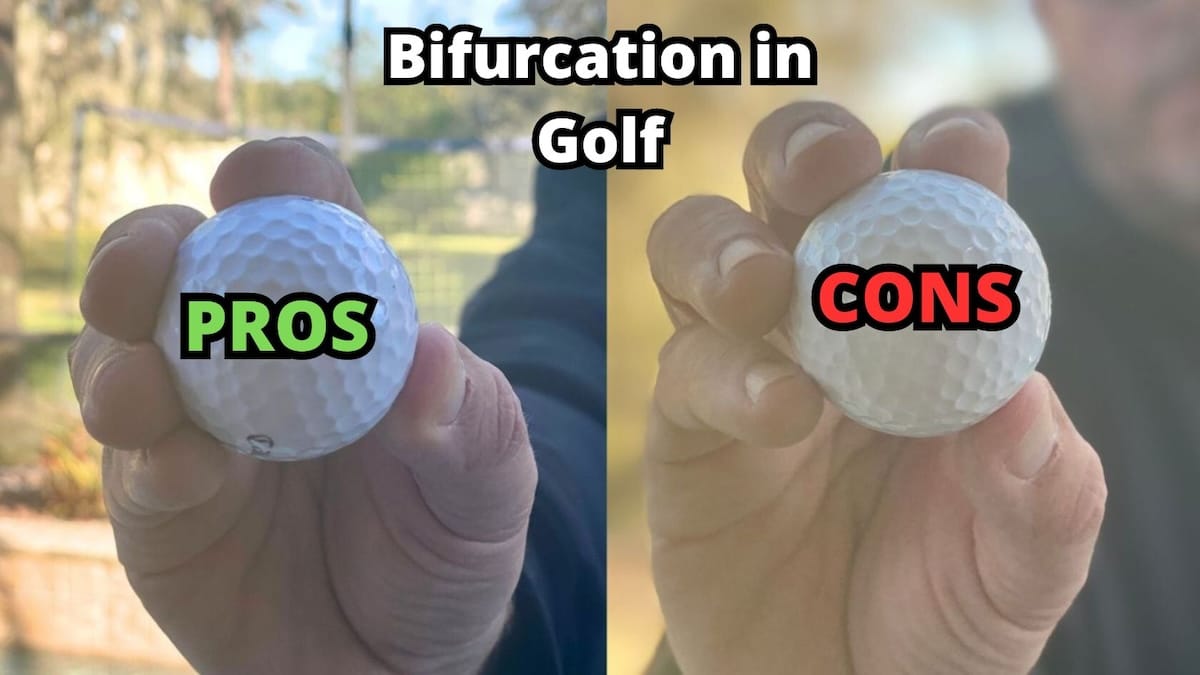The big buzzword recently in golf is “bifurcation,” which means the “division of something into two parts.” In golf, this refers to the growing difference between professionals and average golfers.
Therefore, a new “golf ball rollback rule” has been proposed to close the gap. Basically, pro players may be required to use a competition golf ball. This will limit the longest drivers’ distance by about 3%. Those who don’t hit as far (most amateurs) won’t be initially affected by this.
Why would this happen? PGA tour pros are shredding records at some of the most iconic golf courses and are using the latest golf technology to hit farther than ever before.
So, should pros have to use equipment to limit their performance? Both sides make strong arguments for and against. But some famous voices like Rory McIlroy support an overall distance standard, and there’s a good chance it will be implemented and change golf forever.
Will bifurcation affect your golf game? Read on as I share my experiences as a coach and those of the students I teach.
Will Bifurcation Help Golf?

Yes, I think bifurcation will help increase competition at the highest level and make it more enjoyable to watch big tournaments at some of the world’s most historic golf courses. But it’s not that simple. Here are some pros and cons:
Pros
- Professional players will be forced to play longer shots into greens, thus making it harder to hit shots close to the flag or even to hit greens in regulation.
- Older golf courses will get more opportunities to host more significant events.
- Slow-swing speed players will have a better chance to compete against the long-hitters.
Cons
- The sport loses unification, which has been intact for hundreds of years.
- Players cannot hit as many par-5s in two or drive short par-4s on the average course.
- Amateur players may have to move up a tee if using “competition” equipment.
Want to know how the best golf balls compression rates compare? Check out the full chart.
Bifurcation in Golf: Overview
I’ve always been for bifurcation. I’ve always said that. Just like wood (baseball) bats and metal bats.
-Tiger Woods
Bifurcation focuses on the equipment rules for elite-level players, and it could force them to use only competition-level equipment, similar to the golf ball rollback rule.
In the past, I always thought the chance to play the same equipment and courses as the pros were a part of the allure. However, the average drives of professional golfers continues to go up, leading to the lowest scores in history widening the gap between amateurs. Yes, we’re looking at you, Bryson DeChambeau.
Pros are now outgrowing our golf courses, affecting their design regarding recreational play. Since vacant land is hard to come by, building courses that are bigger and longer is not an option in most cases.
Therefore, some of golf’s higher-ups have proposed guidelines to make different equipment standards for the world’s elite golfers.
This makes sense, right? A similar situation exists in baseball. Amateurs can use aluminum bats, while the pros can only use wooden bats. This is because if professional baseball players used aluminum bats, there would be too many home runs and hits, making it boring for fans and rendering some of baseball’s oldest stadiums obsolete.
Why have the bifurcation rules caused such a debate? Let’s dive right in.
Curious about what equipment pros like Tiger, Rory, and Bryson use? Check out their WITBs.
Current Bifurcation Debate
This latest debate of equipment bifurcation proposes to remove those rights from amateurs and have pros play specific equipment, primarily focusing on the golf ball rollback.
Right now, pros play with the same golf ball regulations we all do. But suppose plans get approved for the proposal of golf ball bifurcation. In that case, the USGA and R&A will require PGA and college-level players to use a specific “competition ball” to dampen distance and create more inconsistency and instability.
Some pros, like Rory McIlroy, support bifurcation, saying that it will make the game more sustainable and won’t affect amateur golfers like us. He also argues that pros already play different equipment and courses because they are offered first dibs on the newest products, and many courses build specific tees when hosting PGA events.
While he is right, I believe it doesn’t stop amateurs from doing the same. If you have the money to buy and customize clubs and golf balls, you can, and if you have the skill and pace of play to contend from the very back tees, then go for it. There’s no universal or local rule stopping you!
On the other side, Brad Faxon has gone on record saying he does not agree with this move because an essential part of the game is that we all play the same equipment, and the game is a true measure of skill because of it.
I agree more with Faxon than McIlroy about continuing with a unified set of rules.
Pros will still have options within the competition ball sub-sector, but the distance will be restrained by roughly 3% across the board. So, someone who hits it long will notice a more considerable difference than someone who already struggles to surpass 285 yards with their driver.
If this goes through, I think it will only be a matter of time before it trickles down to the average recreational game, similar to the wedge groove modifications that went into effect almost ten years ago. Changes are made by governing bodies at the highest level first, then a few years later, applied to the amateur ranks as well. This is the main reason why there’s such a controversy. Most golfers want the chance to get the lowest scores possible.
Curious how to pick the right golf ball for you? Read the full post.
Conclusion
The benefit of bifurcation in golf means that you can watch the pros be challenged in new ways with the new competition golf balls. We also could see better golf courses for recreational players since they won’t need to adapt to super-long pro hitters. Plus, if things continue, your golf game won’t be affected.
However, with bifurcation, you can no longer purchase your favorite pros’ golf balls. Or if it expands, you could buy Rory’s driver, for example. Also, golf will no longer be equal for pros and amateurs, so when we watch the Masters, we don’t know how well we’d be able to play the course. Finally, bifurcation could affect us one day if the rule changes affect amateurs.
Read more
Clint is PGA-certified and was a Head Teaching Professional at one of Toronto's busiest golf academies. He was also featured on Canada's National Golf TV program, "Score Golf Canada," twice. He graduated with a degree in Golf Management from the College of the Desert in California and studied under Callaway's co-founder, Tony Manzoni. He has a handicap index of 6.2 and spends the winters near Oaxaca, Mexico, where he plays twice a month at the Club de Golf Vista Hermosa. He's written over 100 articles at GolfSpan since 2021. You can connect with Clint at LinkedIn, FB, his website, or Clintcpga@gmail.com.







